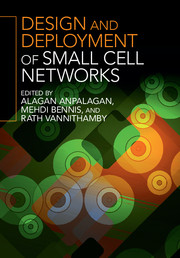Book contents
- Frontmatter
- Contents
- List of contributors
- Preface
- 1 Mobility performance optimization for 3GPP LTE HetNets
- 2 Design and performance analysis of multi-radio small cell networks
- 3 Dynamic TDD small cell management
- 4 3GPP RAN standards for small cells
- 5 Dense networks of small cells
- 6 Traffic offloading scenarios for heterogeneous networks
- 7 Required number of small cell access points in heterogeneous wireless networks
- 8 Small cell deployments: system scenarios, performance, and analysis
- 9 Temporary cognitive small cell networks for rapid and emergency deployments
- 10 Long-term evolution (LTE) and LTE-Advanced activities in small cell networks
- 11 Game theory and learning techniques for self-organization in small cell networks
- 12 Energy efficient strategies with BS sleep mode in green small cell networks
- 13 Mobility management in small cell heterogeneous networks
- 14 The art of deploying small cells: field trial experiments, system design, performance prediction, and deployment feasibility
- 15 Centralized self-optimization of interference management in LTE-A HetNets
- 16 Self-organized ICIC for SCN
- 17 Large-scale deployment and scalability
- 18 Energy efficient heterogeneous networks
- 19 Time- and frequency-domain e-ICIC with single- and multi-flow carrier aggregation in HetNets
- Index
- References
4 - 3GPP RAN standards for small cells
Published online by Cambridge University Press: 05 December 2015
- Frontmatter
- Contents
- List of contributors
- Preface
- 1 Mobility performance optimization for 3GPP LTE HetNets
- 2 Design and performance analysis of multi-radio small cell networks
- 3 Dynamic TDD small cell management
- 4 3GPP RAN standards for small cells
- 5 Dense networks of small cells
- 6 Traffic offloading scenarios for heterogeneous networks
- 7 Required number of small cell access points in heterogeneous wireless networks
- 8 Small cell deployments: system scenarios, performance, and analysis
- 9 Temporary cognitive small cell networks for rapid and emergency deployments
- 10 Long-term evolution (LTE) and LTE-Advanced activities in small cell networks
- 11 Game theory and learning techniques for self-organization in small cell networks
- 12 Energy efficient strategies with BS sleep mode in green small cell networks
- 13 Mobility management in small cell heterogeneous networks
- 14 The art of deploying small cells: field trial experiments, system design, performance prediction, and deployment feasibility
- 15 Centralized self-optimization of interference management in LTE-A HetNets
- 16 Self-organized ICIC for SCN
- 17 Large-scale deployment and scalability
- 18 Energy efficient heterogeneous networks
- 19 Time- and frequency-domain e-ICIC with single- and multi-flow carrier aggregation in HetNets
- Index
- References
Summary
Introduction
The so-called Third Generation Partnership Project (3GPP) Long Term Evolution (LTE) and its evolved version, LTE-Advanced, is currently the most prominent and advanced mobile communication system. When it was designed and standardized, starting in 2004 and first released in 2008 as Release 8, it was targeted mainly for macro base station networks with uniform, well-planned and deployed high-power nodes where coverage, mobility, and the provision of high throughput across large areas are at the heart of its requirements. As a consequence, small cell (or low-power node) deployments together with high-power macro base stations were not considered for the original designs. The specific issues with the introduction of small cells in the system therefore cannot be addressed sufficiently without additional features to deal with interference, mobility, traffic load management, etc., related to such deployments.
The major problems from deploying small cells, especially together with macro base stations, include:
More severe interference conditions. Although interference is always a key issue for cellular communication and handling interference is built into the core of LTE designs, coexistence of network nodes of different power levels, especially in the co-channel scenario where the same frequency channel (known as the component carrier) is used for both macro base station cells and small cells, results in much worse interference condition than before. The LTE system generally has a very robust physical layer design to ensure that each physical channel can be reliably received at fairly low signal to interference-plus-noise ratio (SINR) range. However, in order to fully utilize the potential of small cells to offload traffic, small cells sometimes need to serve users at even lower SINR, which requires a mechanism to either avoid or cope with strong interference.
Mobility management and traffic load balancing. The introduction of small cells with low transmission power basically creates cells with a small footprint within the system, which increases the frequency of handovers between cells due to user mobility. This then results in dramatically larger handover failure as well as associated backhaul signaling. Furthermore, also because of much smaller coverage area, the traffic loads between the cells are more likely to be unbalanced and time-varying, and a more efficient load-balancing and shifting mechanism is needed.
- Type
- Chapter
- Information
- Design and Deployment of Small Cell Networks , pp. 75 - 95Publisher: Cambridge University PressPrint publication year: 2015



